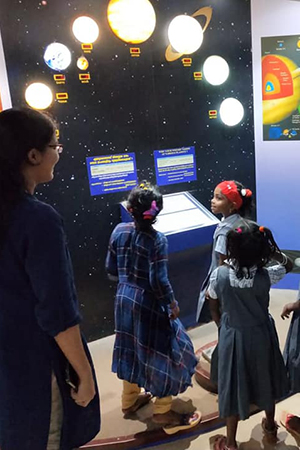" Hall of Astronomy "

From the Paleolithic Age to the Space Age, we have observed stars, planets, the Sun and The moon and tried to explain their motions. The sky has thus been our clock, our navigation tool and a source of endless wonder. We have created a world view for naked eye observation, devised the telescope and extended our visible universe. This has led to another worldview and that demanded another game-changing instrument. Throughout the evolution of astronomy, synergy of imagination and instrumentation have played complementary roles.
The Permanent Gallery on Astronomy in the RSCPC, we have shown the play of this intermingling. A story that unfolds how our seeing got us believing in one universe. How instruments changed it to include many more intricacies – the Cosmic Bakground Radiation to Dark Matter and Dark Energy that still not fully understood.
This gallery depicts the developments in our understanding of the sky and celestial objects, a gradual development of astronomy through ages. It elaborates on various astronomical concepts starting at the pre-telescopic era, then passing through the post-telescopic period, it ventures into the astrophysics of earth and moon and concludes with the quest of human mind in search of the cosmic truth.
There is the observatory of Tycho Brahe with full size sextant; the Indian Astronomy exhibits, the telescope section, the surface of moon where you can pose as an astronaut and see your image in a digital display; then there are sections on eclipses, tides, solar system, deep-sky objects, the celestial sphere, the Foucault pendulum and much more.
The gallery also highlights the location of various Indian observatories. A unique place where one can discover our universe and visualize a cosmic perspective.



